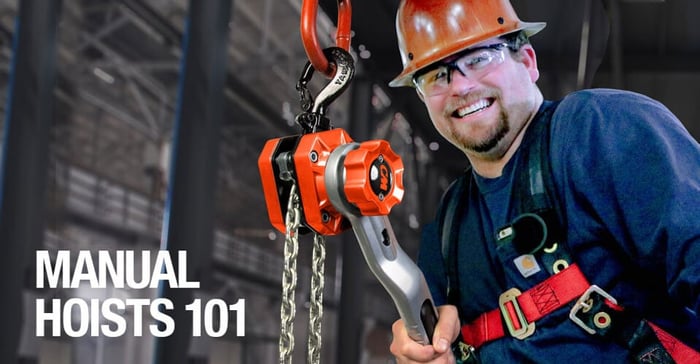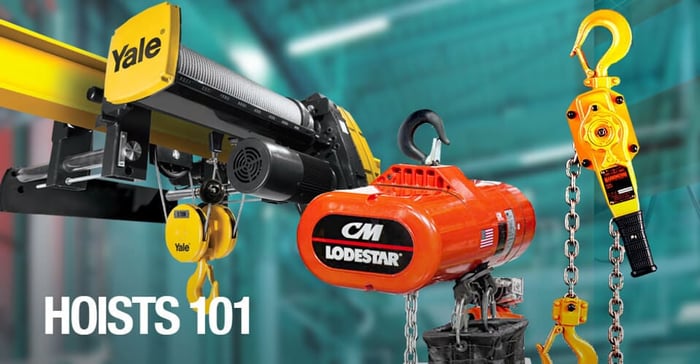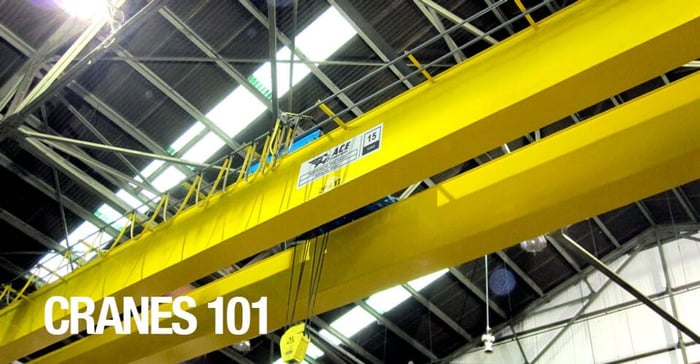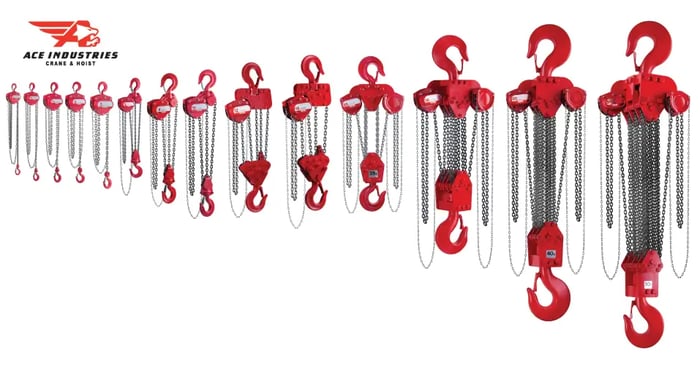
Lever Hoist vs Hand Chain Hoist: What's the Difference?
The pairing of an overhead crane with an electric wire rope or pneumatic hoist can make for some powerful lifting capabilities. Enormous loads are elevated with this type of heavy-duty equipment. If you’re a large manufacturer, a steel supplier, in aerospace or you build transportation vehicles, this can surely come in handy, but that amount of horsepower would be overkill if what you’re lifting is on a much smaller scale. Is your workspace part of an assembly line, a construction site, a fab shop, or even at home in your garage? If so, your lifting job might only require a simple manual hoist.
Manual hoists are easy to use, easy to store, and cheap to maintain. When manual power is the only source you’ve got available and if you’re not counting on speed, you’ll be sure to reach for one of these handy hoists. Tasked to lift 150 lbs of product or materials on the job? You could be asking for a strained back! Without the need to enlist the help of others, a manual hoist can accomplish the same goal with ease and efficiency, with the simple pull of a chain and without endangering your physical safety! Hoist manufacturers like Harrington, CM (Columbus Mckinnon) and Coffing provide great options for manual hoists of all kinds with a variety of capacities and helpful features.
There are two types of manual hoists. Each can help get your job done but their designs are unique from each other: the lever hoist, (also called a come along) and the hand chain hoist (also called a chain fall, chain block, or block and tackle.)
The Difference Between a Lever Hoist and a Chain Hoist
Simply put, the lever hoist operates by cranking a lever attached to a block housing a ratchet and gear system, fitted with a load chain. Hand chain hoists lift when minimal force is applied to a hand chain that turns a cog, the cog turns a driveshaft, the driveshaft turns the gears and the gears lift the load chain to move your materials up or down.
When Should I Use a Lever Hoist?
Lever hoists can lift vertically but are most commonly used when there is a need for stretching or tightening applications, such as for rigging. Because you are powering the tool yourself with a ratcheting motion, movement happens in small increments. Lever hoists are perfect for lifting a boat out of a trailer, for aligning pipes and beams for welding, for tree removal or for securing equipment or smaller vehicles into a truck bed. A slower, manual speed is something to factor in when using a lever hoist if time is an issue and you’re used to working with electric hoists. Each certified lever hoist is made to handle a specific load limit that is wise to heed. They are built in varying capacities from ¼ ton to up to 10 tons.
This hoist can be outfitted with either short handles or long handles. A short-handled lever hoist is mainly used in tight quarters where it is hard to get a full crank that would be needed with a long handle to move a load.
Because lever hoists are simple, compact tools, they can be used to advantage when space is at a premium, and they also possess the flexibility to use while inverted. They can even be operated just using one hand if needed!
Do Lever Hoists Come in Different Duty Classes?
At Ace Industries, we characterize the lever hoists we stock by classification of model based on use, capacity, and features. Light duty and mini lever hoists are the most compact in the market and conveniently fit in a toolbox. These hoists have a wide range of uses in industrial areas such as transportation, construction, and plumbing. Economy model lever hoists and come alongs work well for construction and heavier duty commercial applications and are great for use in close quarters, stretching, and hoisting and are designed to maximize their initial value. The Premium hoists work best in heavy-duty construction work, mining, shipbuilding and day-to-day maintenance tasks.
Lever hoists are perhaps the most versatile hoists in the world. Inexpensive yet powerful, these manual hoists provide portable lifting power with just a few turns of a handle. When selecting a lever hoist, it is important to consider such things as the handle pull required, handle length and frame material.
When Should I Use a Chain Hoist?
Hand chain hoists have many uses in the industry and at home. They can be found on construction sites, shops, and warehouses for loading and unloading goods, also in car service stations and other applications where precise lifting is required, for example in auto shops when lifting engines from vehicles or placing parts is needed.
You would use a chain hoist for lifting vertical loads that travel higher in the air than a lever hoist load. The lever hoist also has to be used right near you but you can operate the hand chain hoist from where you stand on the ground even when the hoist is positioned high up. It also has the capacity to lift larger loads than the lever hoist using mechanical advantage and needs less room to operate. You can attach the chain hoist to a beam, to a secure anchor with a shackle, or to a trolley as a traveling hoist if the load has to be moved from one place to another.
Do Chain Hoists Come in Different Duty Classes?
At Ace Industries, we characterize the hand chain hoists we stock by classification of model based on use, capacity, and features. The Harrington CX hoist is notably the world's smallest hand chain hoist. Its a light duty model and extremely compact design make it the ideal tool for high or difficult to reach places. Economy model hand chain hoists are the practical choice for efficient, trouble-free service. These hoists are designed to be compact and lightweight and are ideal for construction and contractor applications where portability and easy rigging are critical. premium model chain hoists are designed with the total cost of ownership in mind. They’re constructed with top-of-the-line quality components for the most demanding kinds of industrial applications. Built to withstand rugged, day-in, day-out use, these hoists are easily maintained and repairable, making them long-lasting.
Need tips on selecting the right lever or chain hoist for you? View Ace's tips on selecting the right lever hoist, or selecting the right hand chain hoist, or call and speak to a hoist expert at Ace (800) 733-2231.
If you need help picking a manual hoist for your lifting application or have any questions, feel free to contact me at (770) 242-5171.




